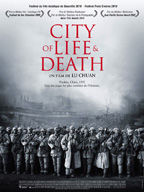

Nanjing! Nanjing!
China 2009
Genre:
War, Drama, Action
Director:
Lu Chuan
Cast:
Hideo Nakaizumi
Fan Wei
Gao Yuanyuan
Jiang Yiyan
Liu Ye
Ryu Kohata
Liu Bin
John Paisley
Qin Lan
Yao Di
Zhao Yisui

City of Life and Death
aka Nanjing! Nanjing!
Story: In the year 1937 Japan invades the Chinese capital Nanjing. Lu Jianxioing (Liu Ye) along with other Chinese soldiers
offers resistance even though the government officials have already fled. They don't stand a chance against the Japanese army which is just better
equipped and organized than them. The city is razed to the ground and numerous captured soldiers are executed. Under the direction of Ida
(Ryu Kohata) the young soldier Kadokawa (Hideo Nakaizumi) has to commit several atrocities. Only thanks to the help of the German John Rabe (John
Paisley) Tang (Fan Wei) manages to erect a refugee camp in which the Chinese are safe for the time being. But this safety is deceiptive. The Japanese
army continues to rape Chinese women and even blackmails Tang to voluntarily send them comfort women from the refugee camp. John Rabe's influence, which
managed to keep the worst away from the camp, more and more fades away. Not only the Chinese are mentally withering away because of the inhuman
treatment from the Japanese army, Kadokawa also struggles not to lose his mind.
Review: Those who are a little bit familiar with Chinese history will already know what they have to expect from this film. The
Nanjing massacre cost the lives of 200.000 people within just a few weeks. Soldiers as well as civilians were cruelly executed. This scar, which is
also known as "the rape of Nanking", China still carries in its collective memory. However, the horror of those weeks will only become apparent if you have
been part of it yourself or if you at least see it at home on screen within the framework of the local secureness of your couch. It is terrible,
disturbing and director Lu Chuan isn't stingy when it comes to using visual stimuli that burn the cruel pictures on your retina. He does so with
visually stunning pictures, refrains from making use of big sentimentality and thus affects even the more.
It would be wrong to call "City of Life and Death" a documentary, though. The film sometimes delivers shaky pictures (but they are at no time annoying),
emotional scenes are captured in a quite dry fashion without any score underlining the mood, the chaos of war is always apparent on screen, yet
Lu Chuan puts certain individuals in the focus of his story and this is a smart decision. As characters they maybe might lack some depth since they
are mainly supposed to carry certain aspects of the movie, but the impressive denseness of the film and the great acting are all adding to the fact
that this small flaw isn't standing out at all. Actually, you even have to wonder how unprejudiced the director is when it comes to drawing his
characters.
It would have been easy to depict Japan as the unscrupulous enemy, who commited unthinkable atrocities on the Chinese people. Lu doesn't make it
that simple for himself, though. Kadokawa even serves as the character in the film you can sympathize with the most. The circumstances created by war,
the vast chaos on the battlefield and his inexperience make him do things that he will never be able to forgive himself for. But he sees his fellow
countrymen do even crueler things. Of course Kadokawa slowly becomes a broken man but while you can see that very clearly there are other characters
whose soul wither away in a subtle way, as is the case with Ida. Or they are already dead within. Ida should actually be called a monster, but
without anyone telling us directly we realize at some point that he solely follows orders as well and deep within maybe hasn't been taken over
by the demon of war completely.
The nazi John Rabe, also known as "China's Schindler", is also portrayed in the movie. He tries to save as many Chinese as possible and especially
in his assisstant Tang it is shown how easy you are willing to cling to a vague hope, because eventually Rabe gets pushed around by the Japanese
and has no real power at all. With some cheap excuse the Japanese are entering and leaving the refugee camp as they please, rape the women there and
at random kill the injured or sick. Or they throw a child out of the window of a multi-story building. The atrocities, especially the raping of
girls who are sometimes merely children, is given a lot of room in "City of Life and Death", but Lu Chuan finds a very effective way to show just as
much as is necessary. That's what is making those scenes even the more realistic and distressing.
At some point we are so shocked of the scale of atrocities - mass executions, beheadings, people buried alive, women who die of the results of their
raping - that you are better off not thinking about the fact that in reality things were even worse. Director Lu Chuan manages to let his pictures
do the talking as he already did in his film "Kekexili". There lies a serene power within those pictures which comes even the more to the foreground as
Lu doesn't put dialogues into focus of his movie but actions. Of course the black-and-white pictures, which are beautiful to look at, and the convincing
sets are also reason for us to feel as if being thrown right into the chaos of war. "City of Life and Death" stands as an important history lesson
which Lu Chuan presents as a fantastically startling anti war movie.

Disclaimer





















